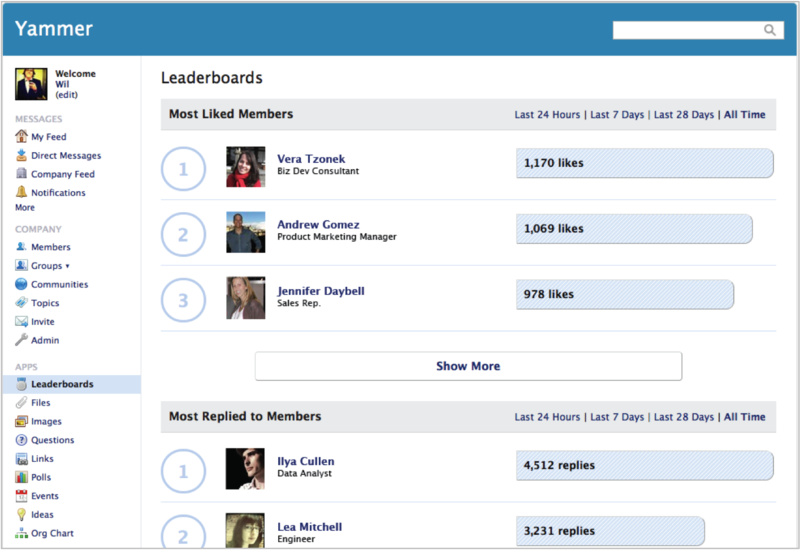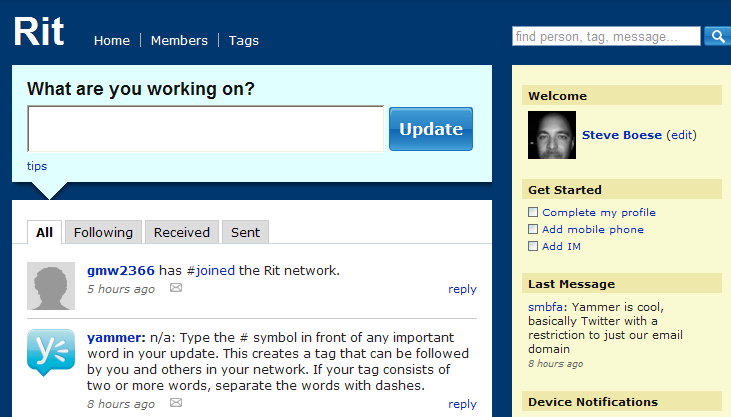Conversation and Being Liked at Work
Last week the popular enterprise microblogging service Yammer, released a new set of features under the name 'Leaderboards'. With the new 'Leaderboards' capability, organizations that have deployed Yammer to support internal sharing and collaboration will now be able to gain additional insights into what conversations and topics are generating the most activity and interest, which employees are the most engaged on the Yammer platform, and how other employees value and respond to topics and each other.
Some of the metrics that the new feature will provide include:
- Most Liked Members: Top 10 users whose messages have received the most ‘Likes’
- Most Replied to Members: Top 10 users whose messages have received the most replies
- Members with the Most Posts: Top 10 users with the most public messages posted
- Most Replied to Threads: Top 10 threads with the most replies
- Threads with the Most Participants: Top ten threads with the most participants
A screenshot of the 'Leaderboards' feature is below:

The Leaderboard offers a small, but important step for organizations that have deployed Yammer as an internal messaging and conversation platform. Having a better view into which employees are most active and 'liked', which employees consistently and effectively engage the community with topics and updates that generate interest and dialogue, and what general subjects and conversations drive the most overall response rates across the entire organization, can provide organizational knowledge and insights into the pulse of the enterprise; and the kind of understanding the is often difficult to discern, particularly in large or dispersed organizations.
Looking at active and popular network participants and assessing what topics and conversation threads generate the most activity are valuable inputs that can lead to potential improvements in organizational design, workforce planning and deployment, and even with creation and execution of business strategies.
What users generate the most engagement? Perhaps their roles in the organization may need to be reviewed and enhanced? Or more likely, the enterprise many need to make sure adequate succession plans exist for these drivers of network engagement?
What topics launch the most conversation? It could be that senior management needs to do a better job articulating their messaging around these topics, or perhaps more attention needs to be paid to a particular popular or recurring theme.
It used to be that managers and leaders could try and sort out what was really going on at work by hanging out in the lunch room, or the watercooler, or the local bar at Happy Hour. Today though, many of the other informal and serendipitous meetings are taking place virtually, in places like Instant Messaging chats and increasingly, enterprise collaboration networks like Yammer.
Still for many managers and leaders, the value of a platform like Yammer may be hard to quantify, but with the development of tools like the Leaderboard, the 'sell' to these decision makers will continue to get easier. Knowing which employees are most engaged, who is capturing the interest of the most of their colleagues, and what conversations and topics are most resonant with the workforce is the kind of insight that can be incredibly difficult for management to gain.
Even if they spend a lot of time hanging around the lunch room and watercooler.
Of course cynics might say that once employees catch on the the metrics that drive the Leaderboard that they will try to find ways to artificially 'game' the system, to raise their profile and position, but in an online platform, with 100% visibility and attribution of comments and activity, it seems like any reasonably healthy community would sniff that out and put a stop to it rather quickly.
Do you use Yammer, or another similar internal microblogging too?
Would this kind of insight into network activity help your organization?

 Steve
Steve


